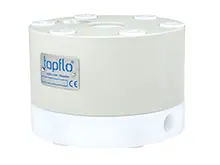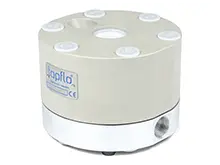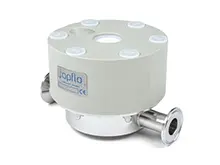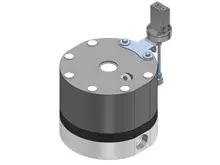The active pulsation dampener is the most efficient way to remove pressure variations on the discharge of the pump.
The Tapflo pulsation dampener works actively with compressed air and a diaphragm, automatically setting the correct pressure to minimize the pulsations.
PE & PTFE pulsation dampeners
Hi-Density Polyethylene has better physical and chemical parameters than standard polypropylene. It is several times more resistant to wear what makes this material ideal for abrasive and aggressive liquids.
Metal dampeners
The aluminium dampeners are perfect to use for pH-neutral fluids. They have great resistance to corrosion and deterioration. They can be found in many applications from workshop, through paint industry to chemistry.
Sanitary dampeners
The sanitary series of Tapflo dampeners has been designed in particular for food, beverage, pharmaceutical and cosmetic industries where cleanliness and sterile environment is necessary.
Options & Accessories
Pulsation dampener with guardian. Pulsation dampener with base. Pulsation dampener with pump.
FAQ
What is a Pulsation Dampener?
A Pulsation Dampener, also known as a Pulse Dampener, is a device used in fluid handling systems to reduce or eliminate pulsations and pressure fluctuations caused by reciprocating pumps or compressors.
How does a Pulsation Dampener work?
A pulsation dampener typically contains a flexible diaphragm or bladder that separates the process fluid from a gas (usually nitrogen) or a compressible liquid. When the pump or compressor generates pressure pulses, the dampener absorbs and smoothens these fluctuations, providing a continuous and steady flow downstream.
What are the benefits of using Pulsation Dampeners?
Pulsation dampeners offer various advantages, including reduced vibration and noise, enhanced system reliability, extended pump and equipment lifespan, improved accuracy in metering applications, and minimized stress on pipes and valves.
Where are Pulsation Dampeners commonly used?
Pulsation dampeners find applications in industries like oil and gas, chemical processing, water treatment, pharmaceuticals, food and beverage, and any process involving reciprocating pumps or compressors.
Can Pulsation Dampeners handle high-pressure systems?
Yes, pulsation dampeners are designed to handle a wide range of pressures, making them suitable for high-pressure applications where pressure fluctuations can be critical.
How do I select the right Pulsation Dampener for my system?
When selecting a pulsation dampener, consider factors such as flow rate, operating pressure, fluid type, connection size, and the level of pulsation reduction required.
Are there maintenance requirements for Pulsation Dampeners?
Pulsation dampeners typically require minimal maintenance. Regular inspection for wear, leaks, and proper gas pressure is recommended to ensure optimal performance.
Can Pulsation Dampeners handle corrosive or abrasive fluids?
Pulsation dampeners can be constructed with materials that offer excellent chemical resistance, making them suitable for handling corrosive fluids. However, for abrasive fluids, it is essential to choose a dampener with appropriate materials and design.
Can Pulsation Dampeners be installed in any orientation?
Pulsation dampeners are usually versatile and can be installed in various orientations, including horizontal, vertical, or at an angle. However, it's essential to follow the manufacturer's guidelines for proper installation.
Can Pulsation Dampeners be used with different types of pumps or compressors?
Yes, pulsation dampeners can be used with different types of reciprocating pumps and compressors, including diaphragm pumps, piston pumps, and plunger pumps, to control pulsations and pressure fluctuations effectively.










